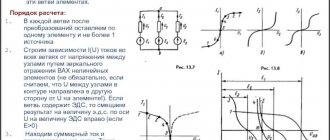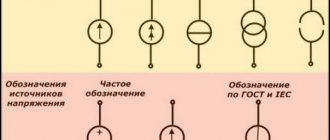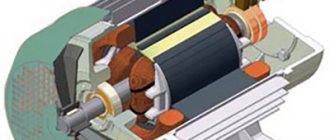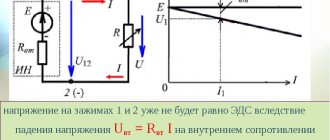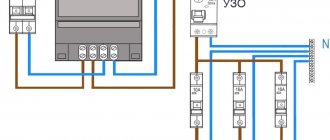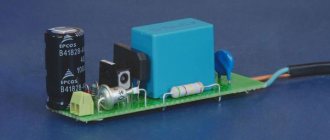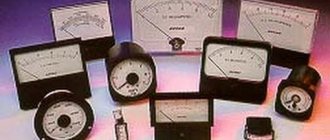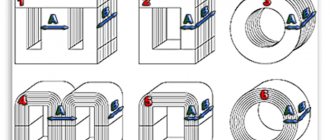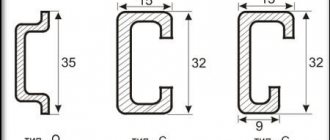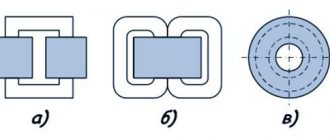A power source is electrical equipment designed to produce, accumulate electrical energy or change its characteristics (defined according to GOST 30331.1-2013).
The power source in the electrical distribution network (see Figure 1 below) is a transformer installed at a step-down transformer substation. Power sources can also be: a local power plant, a separate low-power electric generator driven by an internal combustion engine, and even an isolation transformer, on the basis of which the IT system is implemented in the electrical installation part of the building.
Rice. 1. Power distribution system (TN-CS) (the picture shows the power supply)
Characteristics of available power supplies
When designing electrical installations in accordance with the IEC 60364 set of standards, it is necessary to know the characteristics of power supplies. In order to design a safe electrical installation that meets the requirements of the IEC 60364 set of standards, it is necessary to obtain relevant information from the electrical distribution network operator. Characteristics of power supplies must be included in the design and operational documentation of electrical installations. If the electrical network operator changes the characteristics of power supplies, this may affect the safety of the electrical installation.
Here are these characteristics (according to GOST 30331.1-2013):
- Type of electric current: alternating and (or) constant.
- Types of conductors used in electrical circuits of electrical installations:
— alternating current: phase (linear) conductor, neutral conductor, protective conductor;
— direct current: pole (linear) conductor, middle conductor, protective conductor.
Note - In one conductor, for example, in a PEN, PEM or PEL conductor, the functions performed by several conductors can be combined.
- Valid values:
— voltage and permissible voltage deviations;
— voltage losses, voltage fluctuations and voltage drops;
— frequency and permissible frequency deviations;
— maximum permissible current;
— total resistance of the ground fault loop before entry into the electrical installation;
— expected short circuit currents.
Standard values for voltage and frequency are given in IEC 60038.
Protective precautions inherent to the power supply include, for example, grounding the neutral in an AC electrical system or grounding the live mid-section in a DC electrical system.
However, following characteristics of any power source used and the normal range of these characteristics, if necessary, must be determined by calculation, measurement, collection of material or inspection :
- rated voltage(s);
- type of current and its frequency;
- expected short circuit current at the input of the electrical installation;
- the impedance of the ground fault loop of that part of the electrical system that is located outside the electrical installation;
- compliance with the requirements of the electrical installation, including ensuring maximum load;
- type and rated characteristics of the overcurrent protection device installed at the input of the electrical installation.
These characteristics should be evaluated for both external and internal power supplies. The requirements apply to main power supplies, safety system power supplies, and backup power supplies.
You are currently unable to view or distribute the video lesson to students.
To access this and other video lessons in the kit, you need to add it to your personal account by purchasing it from the catalog.
Get incredible opportunities
Lesson summary “Electricity source parameters”
Before we begin to consider a new topic, let's remember what is generally called a source of electrical energy.
All electromagnetic processes that occur in electrical devices are, as a rule, quite complex. However, in many cases, their main parameters can be described using concepts such as: current, voltage, resistance, power and electromotive force.
In general, a set of electrical devices, consisting of appropriately connected sources and receivers of electrical energy, intended for the generation, transmission, distribution and conversion of electrical energy, is usually considered as an electrical circuit
.
An electrical circuit consists of individual parts (devices) that perform specific functions and are called circuit elements
.
It is clear that the main elements of the chain are sources
and
receivers
of electrical energy.
Electrical devices that produce electrical energy are called sources
or
generators
of electrical energy, and devices that consume it are
consumers
or
receivers
of electrical energy.
So, let's remember the definition: a device that converts any energy (mechanical, chemical, thermal or light) into electrical energy is called a source
.
Examples of electrical energy sources include galvanic cells, batteries, generators and many other devices.
You can even say that in everyday life (that is, at home), the sources of electrical energy are ordinary sockets where we connect kettles, computers, washing machines, and so on.
It is clear that the main purpose of the sources is to supply consumers with electricity
.
All energy sources are called active elements
.
They come in direct
and
alternating
current. However, their parameters are similar.
As we already know, the source produces electrical energy due to the action of some external forces.
Moreover, as a result of the action of an external force, each unit electric charge, when moving inside the source, receives a certain amount of energy.
The amount of energy that a unit electric charge inside a source acquires from external forces is called the electromotive force of the source
(or
EMF
).
The unit of measurement for source electromotive force is volt
.
The operating voltage and power of electric generators are usually indicated on their housing. For example, on the body of galvanic cells their initial electromotive force is indicated.
If it turns out that to power the load, a voltage or current is required that exceeds the corresponding values of one galvanic cell, then a battery is assembled from them. Moreover, the elements connected into a battery must have the same types, electromotive force and internal resistance.
Surely you have heard such a phrase as short circuit
. Everyone, of course, imagines what this phenomenon is, but not everyone can explain it.
Let's try to figure it out.
So, if we connect the electrodes of a current source with a wire, we get exactly what is called a short circuit mode.
With a high power source, the current strength in short circuit mode reaches a very large value, which leads to the release of a large amount of heat inside the electromechanical generator and destruction of the windings in it. Moreover, the current strength can become so great that the wire that closes the electrodes of the source begins to heat up and even melt.
Short circuit current is very dangerous, as it can damage everything: the source of electrical energy, the consumer, and even the connecting wires.
In turn, overheating of the connecting wires can lead to their ignition and fire.
Therefore, when powering devices from powerful sources, short circuit protection is almost always introduced into the consumer. Which, by the way, can happen suddenly, for example, due to device failures, human errors and lightning strikes.
The simplest protection against the devastating consequences of a short circuit is a fuse.
. As a rule, such a device is installed to protect apartment electrical wiring and household electrical appliances.
Fuse
It is a thin wire made of low-melting metal, which is inserted into a glass or ceramic tube. At the slightest deviation in the operation of the electrical circuit, for example, an increase in current strength above the permissible value, the wire heats up and melts. This opens the electrical circuit.
More complex protection against the destructive consequences of a short circuit is the use of various network circuit breakers
.
An example of such machines is a circuit breaker
.
The main function of a circuit breaker is to protect wires and cables from overload and short circuit.
This device is a device that regulates the flow of current in a circuit. The circuit breaker operates using a built-in device that records changes in voltage, frequency and current. So, for example, if the network is overloaded, the thermal relay is triggered and the machine turns off. The speed at which this happens is minimal. Therefore, the use of a circuit breaker guarantees the safe use of several household electrical appliances at the same time and complex equipment in production.
Unlike a fuse, which can only be used once, circuit breakers are designed to repeatedly protect electrical installations from overloads and short circuits.
The parameter of the protection devices is the maximum permissible power, which in this case is specified in the form of the permissible operating current. The magnitude of the current is usually indicated on the body or contacts of the fuses.
If the fuse link in the fuse burns out, it should be replaced with a similar one with exactly the same permissible current value.
Replacing a fuse-link with one with a higher current is very dangerous, as this can lead to an overload of the electrical network and fire of wires and other elements.
We have already found out that the source of electricity provides the consumer with energy with certain parameters. These parameters must necessarily correspond to the parameters of the consumer, otherwise the consumer will not work and will soon fail.
This means that the operating voltage of the consumer must correspond to the operating voltage of the source, and the power consumed by the consumer should not exceed its permissible power.
For example, if you connect an electrical appliance that is designed for a voltage of 220 V to an electrical network with a voltage of 127 V, then it will not be able to work due to lack of energy.
And vice versa, if you connect an electrical appliance that is designed for 127 V to an electrical network with a voltage of 220 V, it will also not be able to work. But for a different reason: the electrical appliance will receive too much energy from the source, which can lead to its breakdown.
In the best case, the fuses will work, protecting it from the resulting overload, but the electrical appliance will still not be able to work.
Lesson summary
In this lesson, we discussed some of the parameters of electricity sources. We learned what is called the electromotive force of the source. We talked about such a dangerous phenomenon as a short circuit. We found out what causes it and what devices help fight it.
Additional power supply types
In addition to the main power source, there will also be a backup electrical power supply and an electrical power supply for security systems. Let us give their definitions and examples.
A standby electrical power supply is an electrical power supply designed to maintain power to an electrical installation or parts thereof, or a part thereof, in the event of interruption of normal power supply, but for purposes other than safety.
An electrical security power supply is an electrical power source designed for use as part of a security electrical power system.
Where the presence of safety systems relevant to fire protection and other conditions for emergency evacuation of buildings is required, for example, by controls and/or if the provision of backup power is required by the administrative person establishing the technical requirements for the electrical installation, the characteristics of power supplies for safety systems and ( or) backup systems must be determined for each individually. Such power supplies must have adequate power, reliability, ratings, and switching times for the specified type of operation.
Note 1 - The need for installation of safety systems and their characteristics are usually regulated by the competent authorities, the requirements of which must be complied with.
Note 2 - Examples of safety systems are: fire detection, warning and fire evacuation control systems, emergency lighting on evacuation routes, emergency ventilation and smoke protection, internal fire water supply, installations for fire pumps, elevators for fire brigades, drainage equipment smoke and heat, critical medical equipment.
Power sources for security systems can be:
- rechargeable batteries;
- galvanic batteries;
- generator sets independent of the power supply used in normal mode;
- a separate transmission line of the electrical distribution network, virtually independent from the transmission line used in normal operation
The power source for the security system can be:
- non-automatic power source, which is started by the operator;
- automatic power source, which is started independently of the operator.
Depending on the switching time, automatic power supplies are classified as follows:
- No power interruption: The automatic power supply can provide continuous power under specified conditions during the transition period, such as voltage and frequency changes;
- with very short power interruption: automatic power supply can supply power within 0.15s;
- with short power interruption: automatic power supply can supply power within 0.5s;
- with medium power interruption: automatic power supply can supply power for 15s;
- with long power interruption: the automatic power supply can provide power for a period of time exceeding 15 s.
Classification of welding types according to physical characteristics
The classification of welding processes according to physical characteristics, although not directly related to the topic of the article, is indirectly related to power sources. Because it is thanks to them that it is possible to perform one or another type of welding.
There are three types of welding based on physical characteristics:
- Thermal
- Thermomechanical
- Mechanical
In thermal welding, the power source must generate an arc that will melt the metal using only its thermal energy. Arc welding, plasma-, electron-, ion-beam welding, electroslag, induction, gas welding - all these are thermal types of welding.
Thermo-mechanical welding involves not only the use of thermal energy, but also the application of pressure. These parameters are necessary, for example, for resistance welding. And also for diffusion, arc, slag, induction-press and furnace welding.
The classification of welding processes is complete without mechanical types of metal welding. With this type of welding, parts are joined under pressure and mechanical energy. These are explosion welding, cold welding, friction welding, etc. This type of welding does not use a welding arc and does not require a power source.
UPS design
The UPS operates from a rechargeable battery located in its case, controlled by an electrical circuit. The battery is charged using a charger, in the presence of mains voltage. This is how the UPS battery ensures that it is always ready for use. To extend battery life, the UPS is additionally equipped with an external battery.
Depending on their purpose, batteries can be used as emergency or buffer batteries. Emergency batteries supply the necessary electricity to the circuit during interruptions in the operation of the main energy source. Buffer batteries are connected in parallel to the main current source to reduce the influence of electricity fluctuations on the source.
